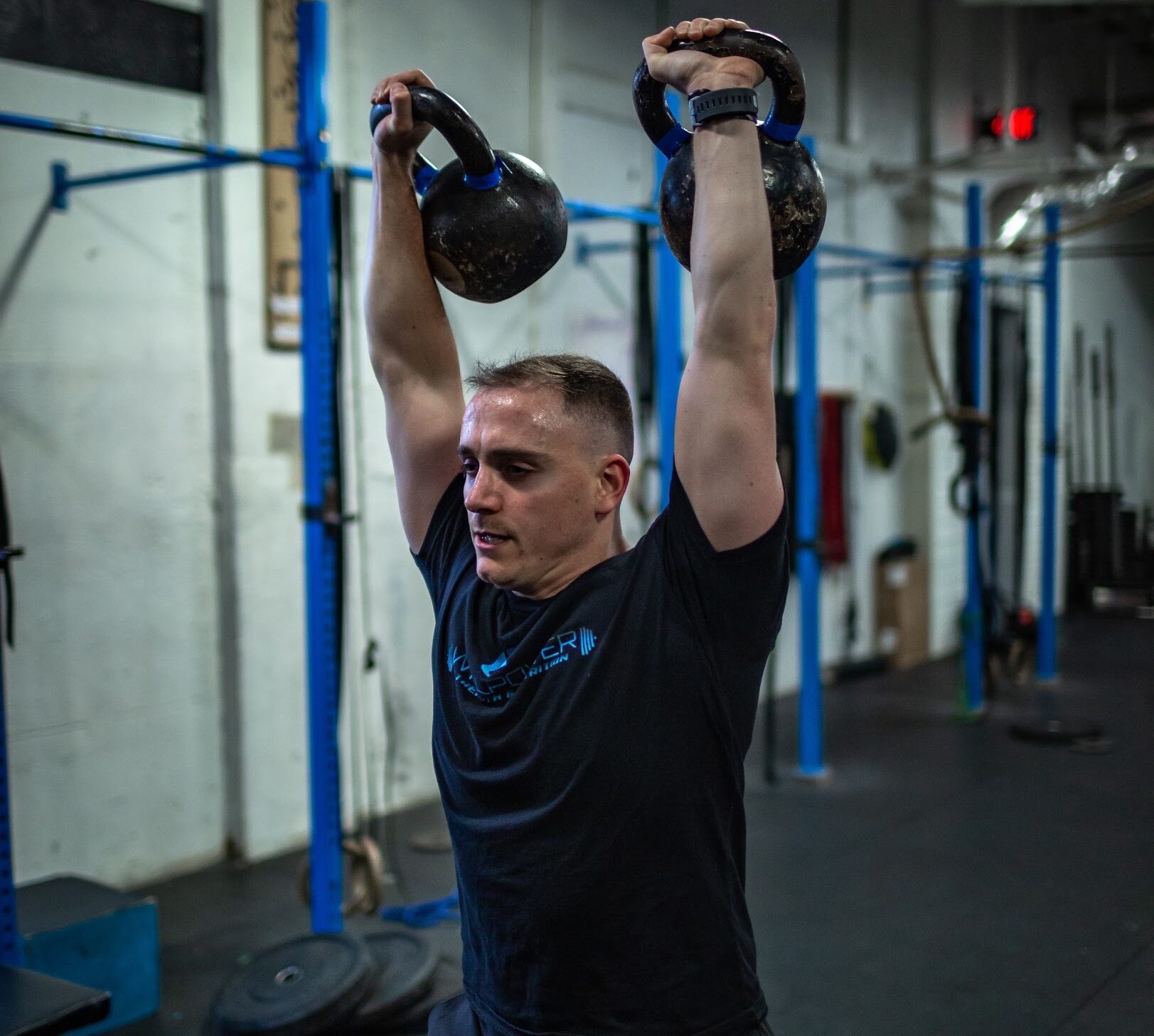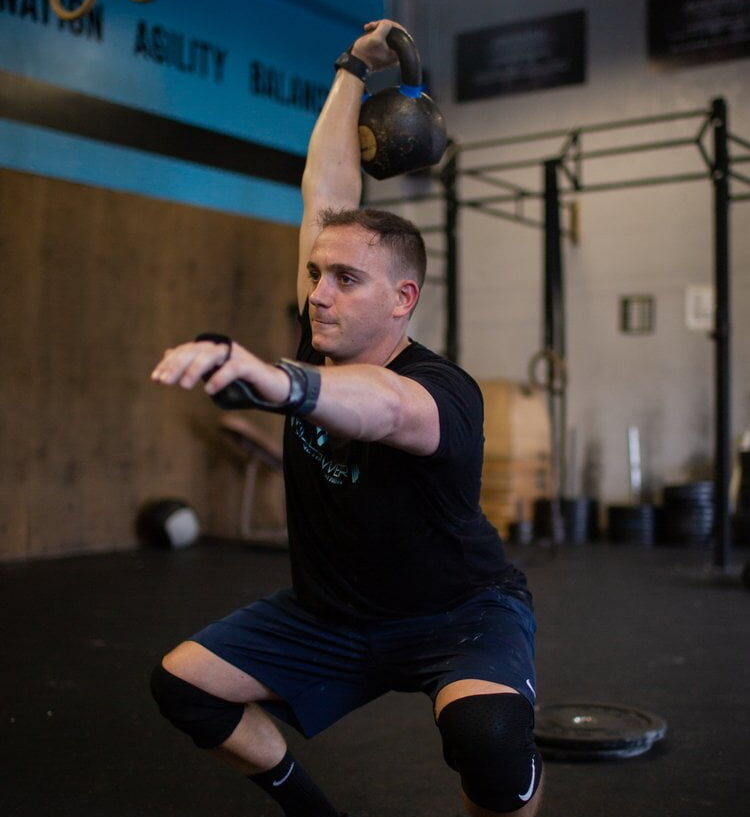Perfecting The Devil’s Press For CrossFit Workouts
Crossfit training is well known for its high-intensity functional training and its focus on multi-joint movements which incorporate a wide range of muscle groups. This is ideal for anyone looking to enhance their fitness but also get the most efficient workout possible since the more muscles engaged, the better the workouts. Just like my clients inside my 1:1 Pain-Free Performance Program.
Among the best exercises and movements in CrossFit that fit this criteria, is the Devil’s Press.
The Devil’s Press is a particularly challenging movement as it includes several movements packaged together and creates a range of motion and time under tension that is longer than most typical movements such as a Kettlebell Swing or Push Press. The packaging of several movements makes the Devil Press stand out as a great full-body exercise that pushes athletes to their limits on each workout.
In today’s blog post, we will dive into optimal technique, the muscles involved, and the benefits of the Devil Press. As well as some common faults that may decrease your performance and potentially put you at risk for injury.
What Is The Devil’s Press?
The Devil Press is a combination of two movements; the Dumbbell Burpee and the Double Dumbbell Snatch. The movement is actually considered an advanced skill and I don’t typically recommend that beginners use this in their training until they have developed the pre-requisite strength, endurance, and skill to make the movement efficient.
Below we’ll review the exact process I use for my clients in my 1:1 Pain-Free Performance Program to incorporate the Devil’s Press effectively in their training.
The Devil’s Press involves moving from a standing position and dropping to the floor into a Push-Up position and performing a Push-Up while lifting a pair of dumbbells off of the ground to a standing position. Then hoisting the dumbbells overhead in one single fluid motion.
Once you have mastered the movements of Burpee, Push-Up, Kettlebell Swing, and Double Dumbbell Snatch you are ready to hit the Devil’s Press in your training.
Now let’s really break down the technique below and take a closer look at the muscles involved in the movement.
Optimal Devil Press Technique
- Start Position: Beginning with your feet directly under the hips, standing shoulder width apart, and a pair of dumbbells on the ground.
- Initiation: Reach down towards the dumbbells and grab them with a neutral grip by hinging at the hips and bending at the knees.
- Push-Up Position: Keep the core engaged and the spine in a neutral position, kick the feet back and assume a push-up position.
- Push-Up: Guide the chest to the ground making contact with the floor and maintaining good form throughout the descent.
- Move To Standing: As you ascend from the push-up, perform a Burpee by bringing your feet forward, and jumping back to a standing position with the pair of dumbbells between the legs.
- Snatch Movement: Using the power of the hips, perform a hip hinge and in one fluid motion move the dumbbells overhead until there is a full extension of your arms.
- Overhead position: To finish the motion the arms should be straight and the dumbbells should be overhead stacked over the wrist, elbow, and shoulder.
- The Return: Lower the dumbells back to the ground by reversing the movement pattern and prepare for the next repetition.
Primary Muscles Used In The Devil’s Press
Since the Devil’s Press is a multi-joint, compound movement it demands the simultaneous coordination and engagement of the multiple muscle groups listed below.
1. Muscles of The Lower Body:
- Quadriceps
- Hamstrings
- Glutes
- Calves
2. Muscles of The Upper Body:
- Deltoids
- Triceps
- Trapezius Muscles
- Pectoralis Major
- Forearm Muscles
3. Muscles of The Core:
- Rectus Abdominis
- Obliques
- Erector Spinae
- Multifidus
Why Include The Devil Press in CrossFit
1. Full-Body Exercise:
As I mentioned above, the Devil’s Press is a full-body movement. This is excellent for CrossFitters because in one movement alone you can train your entire system.
When the entire system is trained it creates a large hormonal impact in the body such as increases in Testosterone, Growth Hormone, and others that have potent body composition, muscle mass building, and performance-enhancing effects.
2. Total Body Conditioning:
There are many ways to use the Devil’s Press in CrossFit WODs (Workout of The Day). It can be performed at low to moderate amounts of weight for higher repetitions to improve your cardiovascular endurance or it can be loaded with heavier weight to push your strength to the next level.
3. Functional Movement:
Since the Devil’s Press involves a hip hinge and overhead movements it mimics the demands of real-life movements which in turn makes it highly functional. If you are using CrossFit to improve your overall fitness level of life then it is highly valuable as it combines multiple movements into one.
For example, the push-up and burpee portion of the movement mimics the action of getting up off of the ground after a fall whereas the Double Dumbbell Snatch mimics motions like lifting a suitcase to an overhead compartment on an airplane.
4. CrossFit Games and CrossFit Open:
At the time of this article, the Devil Press has yet to be included in the CrossFit Open. However, CrossFit HQ’s track record of introducing new movements at any given time signifies that becoming proficient at the Devil Press is in your best interest.
Regardless of whether or not they find themselves in competition, the movement places a huge demand don’t on movement patterns commonly found in the CrossFit Open and thus it can be a great choice for training.
For example, according to Morning Chalk Up, the Burpee and the Snatch are both in the top 10 most commonly programmed movements in the CrossFit Open. The Devil’s Press can train these movements in multiple different energy systems and time domains.
If you’re a competitive CrossFit athlete, the Devil Press may one day show up in CrossFit Open workouts. Thus, training with this exercise ensures you’re prepared for whatever the competition throws your way.
Perfecting the Devil’s Press
In order to optimize the Devil Press movement being able to maintain good form throughout the motion is paramount. This begins with scaling the level of intensity based on your fitness level and focusing on building motor control, muscular endurance, and strength in the movement before moving it into high-intensity Metcons.
1. Motor Control In The Devil’s Presses
Building motor control in the Devil Press will begin with passing several movement screens that you would perform prior to initiating a training program. With regards to motor control for Devil Presses the tests would include:
Once these movements can be performed with satisfactory performance it is assumed that good form can be maintained. Especially on the Push-Up portion and you can start practicing the Devil Press with lower weights and higher reps to build muscle endurance.
2. Muscular Endurance for the Devil’s Press
Building muscular endurance for the Devil’s Press involves progressively challenging the movement pattern moving from high reps with low weights to low reps with heavier weights. As well as going from isolate movement to performing it with other elements and different energy systems.
A common misconception though that because we’ve gotten to this point in the Devil Press progression after motor control is achieved it is fair game to start using it in metcons. This is not the case because as you begin to pair other movements with the Devil Press your ability to maintain good form becomes harder and harder.
If you ever see someone performing the movement and their form has broken down where the back is rounding and they are essentially curling the pair of dumbbells they have likely fast-tracked the Devil’s Press.
Building muscle endurance effectively will avoid this and you do so by following the progression below. This assumes that you have motor control in the assessments above.
Stage 1: Devil Press in isolation
Stage 2: Devil Press with cyclical piece (ex. Assault Bike)
Stage 3: Devil Press with non-interfering movement (Double Unders)
Stage 4: Devil Press with Interfering movement (Kettlebell Swing)
Stage 5: Devil Press with interfering & non-interfering movements in Aerobic Exercise
Stage 6: Devil Press with interfering & non-interfering movements in Anaerobic Exercise (high intensity)
This would be the picture-perfect progression to move the Devil’s Press from never done it to being able to do so inside of a Metcon as each stage builds upon the previous one and has the appropriate level of intensity for you as you build muscular endurance.
3. Strength For The Devil’s Press
Expressing maximal strength in the Devil Press is likely something you wont have to do as a CrossFitter. In my experience as a CrossFit Coach for over 10 years I have never seen an event or workout that tested a one rep max Devil Press.
But, with that being said it can be helpful to have an idea of where your absolute strength lies for the movement so that you can use lighter weights at a percentage of your “one rep max” to improve your ability to perform repetitions at a light or moderate amount of weight in metcons.
Once you have achieved motor control in the assessment tests and achieved great muscular endurance in the skill progression then you can look to improving absolute strength in the Devil Press.
What this would look like are sessions that have you building to various rep maxes such as one rep max, two rep max, three etc. Where the goal is to lift the heaviest amount of dumbbell weight possible to increase the total load you can handle over time.
The Wrap Up!
As you can see the Devil press is a fantastic movement to add to your training if you wish to compete in the sport of CrossFit or are just looking for a great movement to add to your general fitness training. Since the Devil Press combines several movements into one I see it as a great addition to training as long as you have “earned” the right to perform it.
The combination of a Dumbbell Burpee and a Dumbbell Hang Snatch can make this movement particularly hard to maintain good form and keep the spine safe. So although I would definitely recommend performing them in your workouts it is best to first make sure you are ready for them based on a thorough assessment and then scaffold the level of intensity as you move through the progressions I have laid out above and enhance your fitness over time.
Related Reading
The Best Training to Improve Gymnastic Skills In CrossFit
The Best Program For Building Strength In CrossFit







